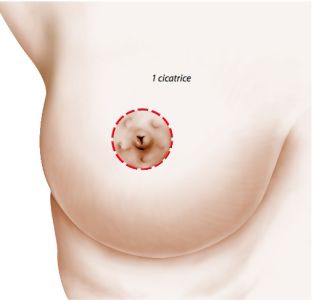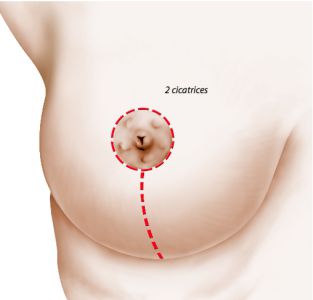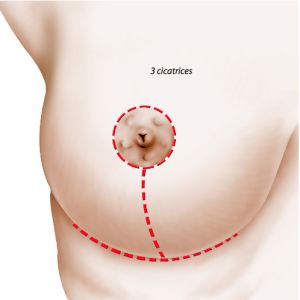

Pexy For Breast Breast Ptosis
This fact sheet was developed under the aegis of the French Society of Plastic Reconstructive and Aesthetic Surgery (SOF.CPRE) as an addition to your initial consultation, to try to answer all the questions you can ask yourself if you plan to use a facelift of the chest. The purpose of this document is to provide you with all the necessary and essential elements of information to help you make your decision with full knowledge of the facts. Also you is it advisable to read with the greatest attention.
• DEFINITION OBJECTIVES AND PRINCIPLES
Breast ptosis is defined by a collapse of the gland and a distension of the skin envelope. The breast is too low and more frequently "uninhabited" in its upper portion.
Ptosis may be immediately but most often occurs after a major weight loss or terminal stage of pregnancy with breastfeeding. It can be isolated: it is called pure ptosis. It can also be associated with some degree of breast enlargement.
One can observe the opposite breast ptosis in the context of a too small breast (mammary hypotrophy or hypoplasia).
These cosmetic flaws do not warrant supported by the Health Insurance.
The back of the areola surgery aims and nipple in a good position to refocus and ascend the gland and remove the excess to get two breasts harmonious, nicely curved and ascended skin.
The operation involves reshaping the breast skin by acting on the envelope and on the glandular tissue. The gland is concentrated and placed in a good position. It should then adapt the skin envelope, which requires removing the excess skin to ensure a good performance and a great shape to the new breast. These gestures are used to replace the areola and nipple were located too low. The banks of the skin that have been cut are sutured after surgery: these sutures are causing scars.
In case of extreme ptosis, scar the shape of an inverted T with three components: the periareolar around the areola between brown skin and white skin, vertically between the lower pole of the areola and the crease under breast, horizontal hidden in the crease under the breast. The length of the horizontal scar is proportional to the amount of ptosis.
More often in the presence of moderate ptosis can be realized with a method called "vertical" which eliminates the cross scar in the crease under the breast and reduce scarring its periareolar and vertical components.
In some cases of breast ptosis very moderate, it is possible to use a technique that allows the correction of busyness with only a scar around the areola.
Finally, when the ptosis is associated with a lack of volume (breast hypoplasia), it may be desirable to set up in the same operation, a prosthesis to restore the breast volume
satisfying. In this case, it is usually possible to remove the excess skin around the areola and thus limit the scar only a periareolar circle.

Mammaplasty for ptosis can be performed from the end of growth and beyond, throughout the lifespan.
A subsequent pregnancy is obviously possible, as well as breastfeeding, but it is advisable to wait at least six months after surgery.
The risk of developing cancer is not increased by this intervention.
• BEFORE THE OPERATION
A usual preoperative assessment is conducted in accordance with regulations.
The anesthetist will be seen in consultation at least 48 hours before surgery.
Besides the usual pre-operative examinations, it may be worth checking the breast imaging (mammography, ultrasound).
No medication containing aspirin should be taken within 10 days before surgery.
• TYPE OF ANESTHESIA AND CONDITIONS OF INTERVENTION
Type of anesthesia:
This is a classic general anesthesia, during which
you sleep completely.
Terms of admission:
Hospitalization for one to two days is usually
necessary.
• INTERVENTION
Each surgeon adopts a technique of its own and it adapts to each case to obtain the best results.
After surgery a modeling bandage with elastic bands shaped bra is crafted.
Depending on the surgeon and the importance of ptosis, the procedure can last from one hour and thirty minutes to two hours thirty minutes.
• AFTER THE INTERVENTION: THE OPERATING SUITES
The postoperative course is usually very painful, requiring only simple analgesics.
Swelling (edema) and bruising (bruises) breasts and a hindrance to the elevation of the arms are frequently observed.
The first dressing is removed after 24 to 48 hours and replaced with a lighter dressing, making a sort of elastic bustier made to measure.
The output takes place from 24 to 48 hours after surgery, then the patient is reviewed in consultation two to three days later.
A bra is then put in place to ensure proper restraint (whose size has been estimated at the time of dressing made at the clinic before the release).
Wearing this bra is recommended for about a month, night and day, after the operation.
The son of suture, they are not absorbable, are removed from the eighth to the twentieth day after the operation.
Should be considered a recovery and a work stoppage for a period of 7 to 10 days.
It is advisable to wait one to two months to resume a sport.
• THE RESULT
It can not be judged until one year after the intervention: chest then most often symmetrical or very close to the symmetry harmonious and natural curve,. Beyond the local improvement, this procedure generally has a favorable impact on the balance of weight, practice sports, clothing options and psychological state.
You only need to have the patience to wait the time needed to mitigate scars and observe during this period proper supervision at the rate of a consultation every three months for one year.
Breast surgery is a breast that is natural and sensible, including hormonal changes.
• FAULTS OF THE RESULT
It is basically scars, which are subject to careful monitoring: they frequently take a look pink and swollen during the second and third postoperative months beyond, they fade usually gradually, become less visible with time.
However, they may remain enlarged, white or brown instead.
Regarding scars, you should know that if they fade well, in general, over time, they do not disappear completely. In this regard, it should
Remember that if the surgeon who performs the suture, the scar, it is the fact of the patient.
Sometimes it can persist for a breast asymmetry, whether the volume, height, size or orientation of the areola.
In all cases, a secondary surgical correction can be made, but you should wait at least a year or two.
• POSSIBLE COMPLICATIONS
Mammaplasty for ptosis, although carried out mainly for aesthetic reasons, it is still nonetheless a real surgery, which involves the risks associated with any medical procedure, however small it may be.
The postoperative course is generally simple to waning of mammaplasty. However, complications can occur, some general, inherent in any surgical procedure, other locoregional more specific mammaplasty.
We must distinguish the complications of anesthesia and those related to the surgery.
For anesthesia, during the consultation, the anesthesiologist will inform the patient himself anesthetic risks. You should know that anesthesia in the body reactions
sometimes unpredictable, and more or less easy to control: the fact of using a fully qualified anesthetist, working in a surgical context, that the risks are statistically almost negligible.
You should know, indeed, that the techniques, anesthetics and monitoring methods have made tremendous progress over the past twenty years, providing maximum security, especially when the operation is performed outside of the emergency and in a healthy person.
Regarding surgery: choosing a qualified and competent plastic surgeon, trained in this type of surgery, you limit these risks, without removing them completely. Fortunately, real complications are rare after a mammaplasty for ptosis made in the rules.
In practice, the vast majority of happens without any problems and patients are fully satisfied with their results. However, and despite their low frequency, you should be aware of possible complications:
The occurrence of infections requiring antibiotics and sometimes surgical drainage treatment.
A hematoma may require an act of evacuation.
necrosis of the skin, rarely seen with modern techniques, may be responsible for delayed healing. Alterations in sensitivity, including nipple can be observed, but normal sensitivity usually returns within 6 to 18 months.
Especially the evolution of scars may be unfavorable to the development of hypertrophic scars or keloids, occurrence and unpredictable changes, which may compromise the aesthetic result of the often lengthy and require specific local treatments.
Thus, in the vast majority of cases, this intervention, although previously studied and performed correctly, gives a very significant result in terms of comfort, even if the inevitable scarring remains the main drawback.
In total there should not overstate the risks, but just be aware that surgery, even seemingly simple, still a small share of hazards.
The use of a qualified Plastic Surgeon ensures that it has the training and skill required to avoid these complications, or effectively treat as appropriate.
These are the pieces of information that we wanted to bring you in addition to the consultation. We recommend that you keep this document, read it again after the consultation and reflect "a clear head." This reflection may raise new questions for which you wait for additional information. We are available to talk during the next consultation, or by phone, or even on the day of surgery when we meet in any way before anesthesia.
MASTOPEXY
AESTHETIC PLASTIC
& RECONSTRUCTIVE SURGERY




© Docteur Garson MAJ 2013